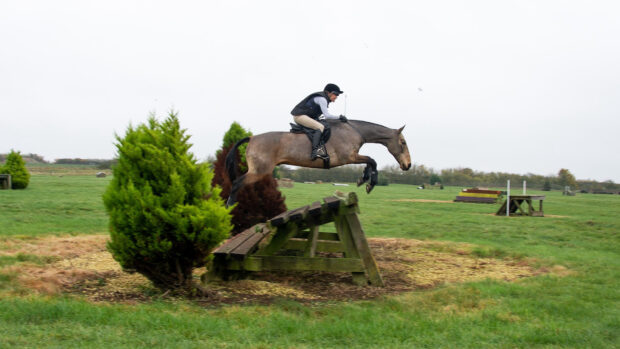We had a fantastic time in Dubai on our family getaway, but we still managed to go to some horse-related activities. We watched some matches at the British Polo Day before going to the Dubai World Cup race meeting the next day where we saw the mighty California Chrome destroy the opposition in the big race.
>>> Jason Webb’s blog: Boosting confidence
The evening ended with the raising of the world’s largest flag (the UAE one of course) to gain a world record, a stunning fireworks display and a performance by Janet Jackson… only in Dubai! I’m going back out in a few months to do some work, which I am hoping will lead to some regular breaks in the sun during the English winters!

With the family in Dubai
Now I’m back home, the yard is in full swing and we have some fantastic horses in for training.
One, a four-year-old warmblood, has set my heart racing a little; his owner has told me that in all her years of breeding youngsters and breaking them in, she has never come across one like this before! Although he has been worked in hand for the past six months, he still displays a strong flight instinct, is very reactive and quick to become irrational; understandably, no one has wanted to get on him! Since his arrival, I have been getting to know him; lungeing, longlining and gaining his trust and respect and yesterday I gave him his first ride which went well (pictured top).

Lungeing the four-year-old
When I have dealt with horses like this before, the main problem has not necessarily been riding them and getting them going, but making them reliable enough to send them home with confidence. Although the vast majority of horses quickly accept a rider and make willing riding horses, there are some that will revert to their flight instinct for years after the starting process. Some horses are made this way by human error, whereas some are just born like it. Either way, after being started under saddle, their future depends on whether their rider can manage this instinct and give the horse confidence each time a reaction happens; not an easy skill. They are certainly not for the faint-hearted but it makes me very happy to see that how time, patience and consistency can lead to these horses and their riders forming successful partnerships.
>>> Jason Webb’s blog: All eyes on you?
I’m also having the pleasure of teaching the ropes to some young riders who are keen to make training horses their profession. I love teaching and I am always interested in finding different explanations and exercises to help gain improvements or overcome common problems. So I found it interesting reading the feedback on an article that I contributed to the H&H website about mounting, which ranged from “This is really interesting, can’t wait to try it” to “Is this a joke? This bloke doesn’t know what he’s talking about!” As I have always said, my methods aren’t going to suit everyone, but they are tried and tested by my clients and although they may be a bit “different”, if approached with an open mind they could really help!

Starting the flighty four-year-old
The great thing about the internet and social media is that there is so much information, support and help available out there but the downside is that it is very easy to be an expert behind a computer screen and pass judgment with comments that would rarely be said to someone’s face. However, I realised a long time ago that anyone who is prepared to put themselves out there has to have a thick skin; I now need to persuade my wife to get one as she still gets very overprotective of me!
>>> Jason Webb’s blog: Serious prospects
I’m also getting around with a bit of a smile on my face as one of my young polocrosse horses is shaping up nicely. Sea Breeze is a five-year-old Thoroughbred by Osh Kosh, one of polo player Alan Kent’s stallions, and is an out and out athlete with power and speed to match her agility. Unfortunately she’s also mad as a box of frogs, but the old saying “horses for courses” could not be more true; she’d be hopeless for most other disciplines but she could well develop into the best polocrosse horse I have ridden — I love her!
Jason




